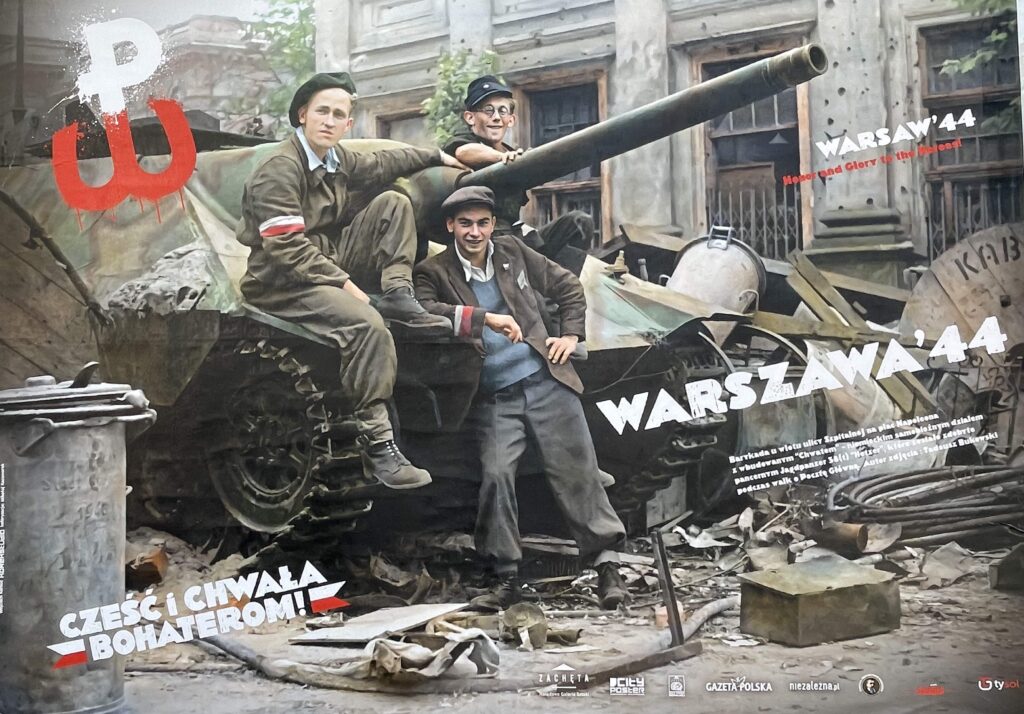
Seventy-nine years ago Warsaw’s historic Old Town was being leveled by Stuka dive bombers, artillery and mortars. After an unsuccessful attempt to break through the German encirclement to create a corridor to the City Center, the Polish Home Army was forced to evacuate soldiers and civilians through the sewers (kanały). Thousands survived the harrowing journey through the darkness and mire, though many would never emerge.
While the valiant struggle would continue until the beginning of October 1944, conditions rapidly deteriorated and the areas occupied by the insurgents contracted. The Soviet Red Army occupied the Praga District on the right bank of the Vistula, but stood idle as their former ally decimated the capital city and military forces of their long-time foe. An echo of the Hitler-Stalin Pact signed on August 23, 1939.
Unlike many anniversaries that focus on a single date (e.g. the attack on Pearl Harbor, D-Day, the bombing of Hiroshima and Nagasaki), the August 1 commemoration of the outbreak of the Warsaw Uprising opens a two-month long period of reflection on those momentous days that consumed Poland’s capital and more than 200,000 of her citizens. In this age of social media, many people pay tribute to the fallen by daily posts tracking the timeline of the battle:
Day 24: #WarsawUprising
In Śródmieście there are 100 kitchens and 40 dressing stations. The kitchens make several thousand meals a day. When we talk about the Uprising we tend to forget the women who fed the insurgents. They played a vital role in this fight for freedom. pic.twitter.com/tSZoucqCB7— Alina Nowobilska🇵🇱 (@WW2girl1944) August 24, 2023
🇵🇱Tego dnia 79 lat temu kpr. pchor. Witold Kieżun ps. “Wypad” został uwieczniony w sytuacji, gdy właśnie jego oddział zakończył zwycięską potyczkę z Niemcami.
W rękach niósł zdobyczny niemiecki ciężki karabin maszynowy. pic.twitter.com/6QG1eNAVrS— Mikołaj Kaczmarek (@KolorHistorii) August 23, 2023
Dr. Marek Jan Chodakiewicz, The Kosciuszko Chair in Polish Studies at the Institute of World Politics in Washington D.C., graciously agreed to share his article “The Warsaw Rising, 1944: Perception and Reality” (below) which is another valuable source for reflection on those times. Though nearly twenty years have passed since it was written, it’s one of the relatively scarce scholarly treatments of the subject in English that addresses a number of pertinent issues in an even-handed way. These include the under-appreciated participation of Polish nationalists in the Uprising (and in the underground resistance generally), and the role of communist insurgents and the Jewish population during the battle.
Though spectacular and significant, the Warsaw Uprising was the culmination of five years of wide-ranging and meticulously-planned resistance activities that included: sabotage, prison-breaks, diversion, propaganda, and perhaps most significantly, intelligence gathering that supplied the Allies with much of their most valuable wartime information.
The issues raised by Dr. Chodakiewicz are a useful starting point to understanding the infernal vise that Poland was trapped within during World War II. Both professional and amateur students of history will benefit from seeking to understand the consequences of that terrible conflict and how they continue to weigh heavily on Eastern European nations.
Also by Dr. Chodakiewicz: Intermarium: The Land Between the Black and Baltic Seas
You can watch the CNN documentary referred to in the article, “Warsaw Rising: The Forgotten Soldiers of World War II” from 2004 on YouTube.
Note: Right-click and “Open in Preview” to read/save the article as a PDF on Mac. Windows/mobile should be similar.